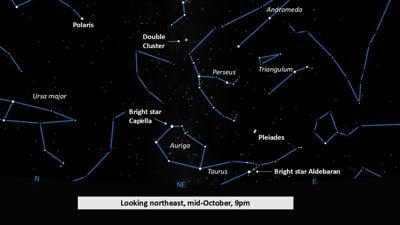Welcome to October, the first full month of Autumn. Nights grow significantly longer this month. By the end of October, sunset comes before 6 p.m.! Earlier darkness makes for good evening stargazing, when skies are clear. Nights are colder, but not as frigid as in winter.
October will be an excellent month in which to view Saturn. The ringed planet made its closest approach to Earth in September, but is still close to Earth this month. And, it will be in better position for evening viewing. At its September 21 opposition, Saturn rose at sunset, and was at its highest in the night sky (and easiest to see) at about midnight. In mid-October, Saturn will be about 30 degrees above the horizon at 9 p.m. Look for Saturn as the bright “star” in the southeastern sky, below the great square of Pegasus.
The bright planets Jupiter and Venus are still early morning objects in October. Bright Venus will be prominent, low in the east before sunrise. Jupiter will be high in the southeastern morning sky. Both will be very bright, outshining everything except the Moon in October night skies.
Mars and Mercury will be low in the west after sunset, and difficult to see unless you have a clear view of the western horizon. In mid-October, the two planets will be very close to each other. Look low in the southwest after sunset. Mercury will be brighter, with dimmer Mars directly above it on the 18th.
The Moon begins October low in the south, in Capricornus. It will be just past its first quarter stage. On the 5th, the almost full Moon will lie just above Saturn, and just above faint Neptune. October’s full Moon (harvest Moon) will come on the 7th. It will be a “super moon,” about 13% brighter than average. On the 9th, the waning gibbous Moon will cross in front of the bright star cluster Pleiades. Check it out with a pair of binoculars. On the 16th, in the early morning sky, look for the Moon above the bright star Regulus high in the southeast.
On the night of October 22-23, the Orionid meteor shower will be at its peak. The Orionids originate from the famous comet Halley, which enters the inner solar system every 76 years. The comet is named after Edmund Halley, who first theorized that comets orbit the Sun and periodically return to the inner solar system. In 1682 he observed the comet that later carried his name, and calculated that it would return in 1758. Its return in that year proved Halley’s theory.
Though not as prolific as the Perseid shower, the Orionid peak this year will occur just after new Moon, with no interference from moonlight.
As mentioned earlier, on October 9 you can check out the Moon crossing in front of the bright star cluster Pleiades. While that will be an interesting view, you can get a better impression of the star cluster on dark nights, when the Moonlight does not interfere. While you are doing that, see if you can find another pretty pair of star clusters, the double-cluster in Perseus. Check out the picture with this article for the location of these two gems.
I almost forgot, what about Halloween? On the 31st, the waxing gibbous Moon will be about 75% illuminated, providing a nice amount of light for treat-seeking youngsters.
Enjoy the night skies of October!
























Commented
Sorry, there are no recent results for popular commented articles.